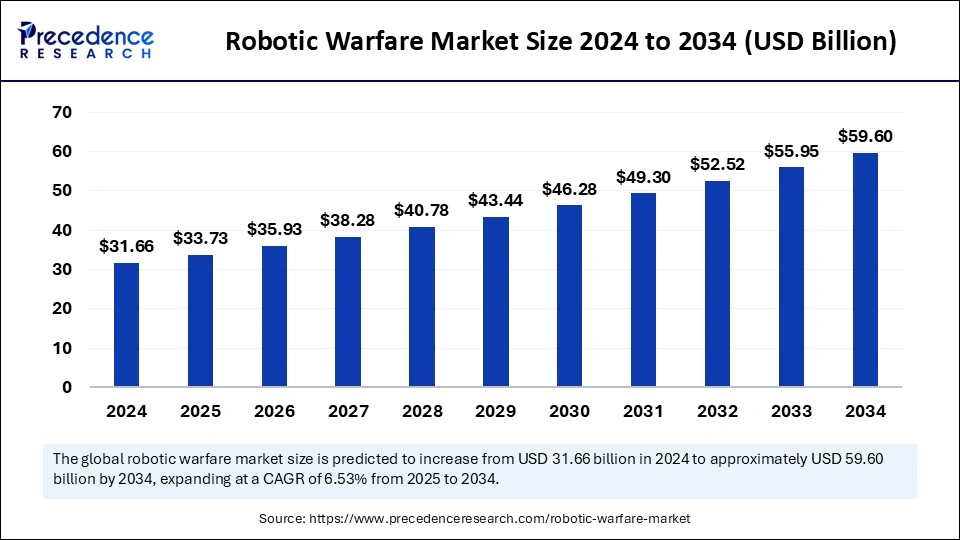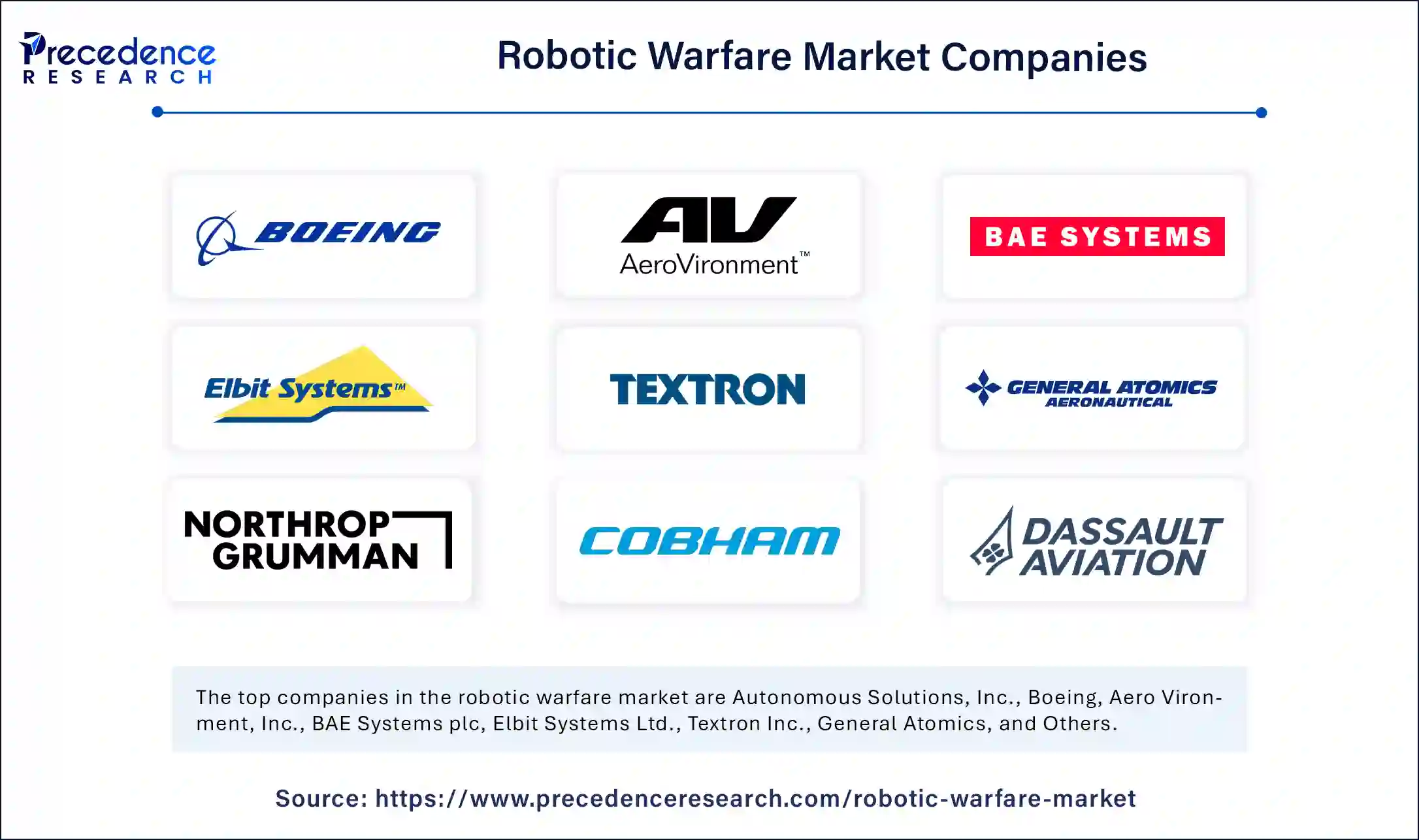The global robotic warfare market size was valued at USD 31.66 billion in 2024 and is expected to gain around USD 59.60 billion by 2034, growing at a CAGR of 6.53% from 2025 to 2034.

Get a Free Sample Copy of the Report@ https://www.precedenceresearch.com/sample/5813
Robotic Warfare Market Key Insights
-
In 2024, North America dominated the market with the highest share of 41%.
-
Asia Pacific is anticipated to grow steadily with a strong CAGR during the forecast period.
-
The semi-autonomous operation mode held the largest market share in 2024.
-
By capability, unmanned platforms and systems contributed the largest share in 2024.
-
The exoskeleton and wearables capability segment is projected to see significant growth during the forecast period.
-
Intelligence, surveillance, and reconnaissance applications led the market in 2024.
-
The search and rescue applications are forecasted to expand significantly in the next few years.
Impact of Artificial Intelligence on the Robotic Warfare Market
-
Autonomous Systems
AI is a driving force behind the development of autonomous robotic systems used in warfare. These systems are designed to operate without human intervention, from unmanned ground vehicles (UGVs) to autonomous aerial vehicles (UAVs). By leveraging AI, these robots can make real-time decisions based on their surroundings, mission objectives, and sensor data, which allows them to perform complex tasks such as surveillance, reconnaissance, and even combat operations more efficiently than human operators. -
Enhanced Decision-Making and Speed
AI algorithms are used to analyze vast amounts of data from various sources in real-time, helping military commanders make faster, more informed decisions. In robotic warfare, AI can process data from battlefield sensors, satellite feeds, and reconnaissance drones to assess threats and opportunities, giving military personnel the ability to respond rapidly to changing conditions on the ground. This quick decision-making capability can be crucial in high-stakes situations where every second counts. -
Targeting and Precision
AI is playing a significant role in improving the precision of robotic weapons systems. Using machine learning and computer vision, robots equipped with AI can enhance their targeting capabilities by identifying and tracking specific targets with high accuracy. This reduces collateral damage and increases the effectiveness of military operations. AI can also be used for predictive targeting, allowing robots to anticipate enemy movements and adjust their strategies accordingly. -
Swarming Technology
One of the most revolutionary applications of AI in robotic warfare is the concept of swarming. AI enables the coordination of multiple autonomous robots to work together as a unified force. These swarms can carry out complex tasks such as surrounding and overwhelming an enemy position, providing enhanced tactical flexibility on the battlefield. The use of AI to manage these swarms also ensures that they can adapt to new environments and scenarios without human intervention. -
AI-Driven Cybersecurity
As robotic systems become more integrated into military operations, their vulnerability to cyberattacks increases. AI is being employed to enhance the cybersecurity of robotic warfare platforms by detecting and responding to potential threats in real-time. By using AI-based anomaly detection and predictive threat models, military forces can safeguard their robotic assets from cyberattacks, ensuring that they remain operational in combat situations. -
Ethical and Regulatory Considerations
While AI offers significant advantages in robotic warfare, it also raises important ethical and regulatory concerns. The use of autonomous robots in combat decisions, especially lethal force, has sparked debates about accountability, morality, and the risk of AI making mistakes or being exploited by adversaries. As the technology evolves, governments and international organizations will need to develop regulations to manage the use of AI in warfare, balancing technological advancements with ethical standards.
Robotic Warfare Market Growth Factors
-
Advancements in AI and Robotics Technology
Continuous innovations in artificial intelligence (AI), machine learning, and robotics are enhancing the capabilities of robotic warfare systems. These advancements enable robots to perform more complex tasks autonomously, improving decision-making, targeting, and operational efficiency on the battlefield. -
Increased Military Budget Allocations
Governments worldwide are increasing their defense budgets to modernize their armed forces and keep pace with technological advancements. As part of this, they are investing heavily in robotic and autonomous systems to improve combat capabilities, enhance safety, and reduce operational costs. -
Minimizing Human Casualties
Robotic warfare systems reduce the need for human soldiers in high-risk combat situations, thereby minimizing casualties and ensuring safer military operations. The desire to protect soldiers from hazardous environments, such as in combat zones or dangerous reconnaissance missions, is a significant driver of market growth. -
Enhanced Surveillance and Reconnaissance Capabilities
Robotic systems, such as drones and unmanned ground vehicles, offer improved surveillance, reconnaissance, and intelligence-gathering capabilities. These systems provide real-time data analysis, aiding in mission planning and execution, and offer a strategic advantage over adversaries. -
Increased Adoption of Autonomous Systems
The growing reliance on autonomous and semi-autonomous systems in various sectors, including defense, is driving the robotic warfare market. The ability of autonomous robots to operate with minimal human intervention increases their efficiency and effectiveness in combat, surveillance, and logistics. -
Swarm Robotics Technology
Swarm robotics, which allows multiple robots to coordinate and operate together as a collective unit, is gaining traction in military applications. This technology enables efficient, scalable operations for tasks like reconnaissance, search-and-rescue missions, and offensive operations, contributing to market expansion. -
Improved Cybersecurity Features
As robotic warfare systems become more sophisticated, there is a growing emphasis on developing advanced cybersecurity measures to protect them from cyberattacks. Enhanced security features make these systems more reliable and safer for deployment, driving their adoption by military forces. -
Strategic Geopolitical Shifts
Global geopolitical tensions and regional security concerns are leading to an increased demand for advanced defense systems, including robotic warfare technologies. Military forces are looking to stay ahead of adversaries by adopting cutting-edge robotics to maintain their technological edge. -
Cost-Effectiveness and Scalability
Robotic warfare systems can offer a cost-effective alternative to traditional military assets, such as manned aircraft, ground vehicles, and naval vessels. Their scalability allows for widespread deployment, making them accessible to a wide range of defense forces across various budgets. -
Global Military Modernization Programs
Many nations are undergoing large-scale military modernization programs to update outdated defense infrastructure. Robotic warfare systems are being integrated into these modernization efforts to improve capabilities and prepare for future threats in an increasingly technology-driven combat environment.
Market Scope
| Report Coverage | Details |
| Market Size by 2034 | USD 59.60 Billion |
| Market Size in 2025 | USD 33.73 Billion |
| Market Size in 2024 | USD 31.66 Billion |
| Market Growth Rate from 2025 to 2034 | CAGR of 6.53% |
| Dominated Region | North America |
| Fastest Growing Market | Asia Pacific |
| Base Year | 2024 |
| Forecast Period | 2025 to 2034 |
| Segments Covered | Mode of Operation, Capability, Application, and Regions |
| Regions Covered | North America, Europe, Asia-Pacific, Latin America and Middle East & Africa |
Market Dynamics
Key Drivers
Key factors fueling the market’s growth include technological breakthroughs in robotics and AI, which improve the autonomy, intelligence, and effectiveness of military platforms. The rising demand for more efficient and precise military solutions, along with the growing need for surveillance and reconnaissance in modern warfare, is pushing the adoption of robotic warfare technologies.
Opportunities
There are numerous opportunities within the market, particularly in enhancing robotic swarm capabilities, which allow for coordinated actions among multiple units. Additionally, ongoing defense modernization initiatives in emerging economies are opening doors for robotic warfare systems to be integrated into new and existing military infrastructures. AI integration into robotic systems is also expected to increase their effectiveness and decision-making power.
Challenges
The primary challenges include the high costs associated with developing advanced robotic systems, technical issues in integrating these technologies into existing military structures, and regulatory concerns around the deployment of autonomous weapon systems. Furthermore, the complexity of cybersecurity in defending against potential hacking of robotic systems remains a significant issue.
Regional Insights
North America leads the robotic warfare market due to its technological dominance and defense expenditure. Europe is also a strong player, driven by collaboration among NATO countries. The Asia-Pacific region is witnessing rapid growth, particularly in China and Japan, where there is an increased focus on innovation in defense technologies.
Robotic Warfare Market Companies

- Autonomous Solutions, Inc. (ASI)
- Boeing
- Aero Vironment, Inc.
- BAE Systems plc
- Elbit Systems Ltd.
- Textron Inc.
- General Atomics
- Northrop Grumman Corporation
- Cobham plc
- Dassault Group
- Lockheed Martin Corporation
- Thales Group
Recent Developments
- In January 2025, L3Harris attached an advanced multirole electronic warfare (EW) capability to a T7 robot and demonstrated it at Vanguard 2024, an annual capstone experiment the U.S. Army hosts at Fort Huachuca, Arizona. This attached detected and defeated small unmanned aircraft systems (sUAS) with the CORVUS-RAVEN system and sensed, monitored, and decoded electronic signals using the Individual CORVUS Node.
- In February 2025, Estonia-based Milrem Robotics revealed its new 8×8 wheeled combat robot, dubbed Havoc, a mockup of a new hybrid-electric vehicle.
In March 2025, Ukraine established the world’s first Unmanned Systems Forces (USF) to advance unmanned and robotic warfare capabilities across air, sea, and ground domains.
Segment Covered in the Report
By Mode of Operation
- Autonomous
- Semi-Autonomous
By Capability
- Unmanned platforms & systems
- Exoskeleton & wearables
- Target acquisition systems
- Turret and weapon systems
By Application
- Intelligence, Surveillance, and Reconnaissance
- Logistics and Support
- Search and Rescue
- Combat and Operations
- Tracking and Targeting
- Training and Simulation
By Region
- North America
- Europe
- Asia Pacific
- Latin America
- Middle East and Africa
Also Read: High Voltage Direct Current (HVDC) Capacitor Market
Ready for more? Dive into the full experience on our website@ https://www.precedenceresearch.com/
- Aluminum Composite Panel Market Size to Attain USD 12.82 Billion by 2034 - April 15, 2025
- Full Service Restaurant Market Size to Surge USD 22.34 Billion by 2034 - April 15, 2025
- Edge AI Accelerator Market Size to Attain USD 113.71 Billion by 2034 - April 15, 2025
